Renfrew Ferry
The Renfrew Ferry is a passenger ferry service linking the north and south banks of the River Clyde in Scotland. The service, operated by Clydelink without subsidy, crosses between Renfrew and Yoker, close to Glasgow City Centre and is the last Clyde crossing this far upstream.
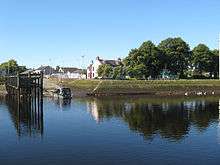
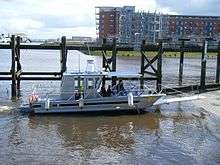
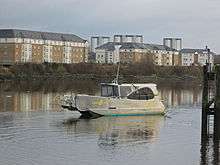
History
Originally the service operated from King's Inch, further upstream on land which is now the site of the Braehead Shopping Centre, but moved around two hundred years ago to better serve the town of Renfrew. In the 1960s there were many other crossings operating close to the Renfrew Ferry, mainly serving the dominant shipyards of the Clyde. The Erskine, Whiteinch, Partick, Govan and Finnieston ferries have all stopped providing the services as bridges and tunnels replaced them, but the Renfrew Ferry, being at a point where both tunnelling and bridging are difficult, has survived. It is the last operational Clyde crossing this far upstream, and the closest to Glasgow City Centre.
The service was passenger-only until the car boom of the 1950s and 1960s, when it became a car ferry. With the opening of the Clyde Tunnel just two miles upstream, which allowed faster crossings, the car service ceased in May 1984.[1] Now, due to expanding car use, the tunnel and surrounding routes are themselves frequently congested. One of the old car ferries can still be seen moored on the Broomielaw, in the city centre of Glasgow, where it is a popular entertainment and nightspot, also called the Renfrew Ferry.[2][3]
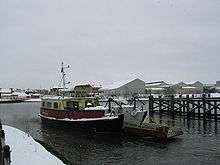
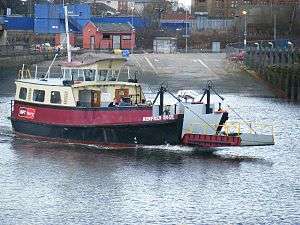
From 1984 until 2010 Strathclyde Partnership for Transport (SPT) operated two passenger-only boats, appropriately named the MV Renfrew Rose and Yoker Swan. In 2007, a study was started to see the feasibility of replacing the ferry with a bridge, which would allow 24-hour crossings.[4] It would be necessary for the bridge to have a large clearance or be able to open, due to shipbuilding and other river navigation upstream on the River Clyde. The study found that a replacement bridge would cost around fifteen million pounds.[5]
The Strathclyde Partnership for Transport service ended at the end of March 2010, as part of moves to save £2.5m from their budget. The ferry was making an annual loss of £430,000[6] and SPT was providing a £3 subsidy for every £1.20 fare paid by passengers. Trials took place to ensure a seamless transition to a private sector service without subsidy.[7] Five contenders included Scottish bus company Stagecoach Group, with an amphibious bus.[8] and Inverness-based Clyde River Taxis.[9] The successful company was Argyll-based Silvers Marine, operating as Clydelink, with a small, fast ferry.[10] They inaugurated their service using a William E. Munson Company aluminium vessel, capable of carrying 12 passengers.
The Renfrew Ferry figured prominently in the trial of Peter Manuel, with the ferryman as a key witness.
Service
The crossing, between the area of Yoker in Glasgow and the town of Renfrew in Renfrewshire, is only 200 metres, with graded slipways on each side. The service operates between 6.30 am and 9.30 pm, being on-demand at peak times and half-hourly at other times. The company plans to extend the service to Braehead.[11] The service has had reliability issues, with two weeks out of service in 2017 and three weeks in 2018 as of late June.
Transport links
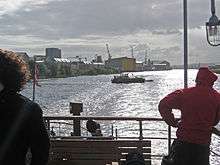
The Renfrew Ferry was a dedicated bus terminus on the southern side. In recent years, the opening of Braehead Shopping Centre has seen most services divert via Ferry Village to Braehead Bus Station, and few services now stop at the ferry slipway, most stopping some 200m away. Services from FirstGroup and McGills are operated to Paisley, Govan, Renfrew, Glasgow, and Glasgow Airport.
The northern side is located near Dumbarton Road, which is a major bus artery with numerous services. These are operated to destinations such as Helensburgh, Clydebank, Anniesland, Partick and Balloch.
The large volume of onward transport available highlights that it serves a much larger area than just the immediate population around the ferry, and is an important public transport link in the west of the Greater Glasgow conurbation.
References
- "Renfrew – Yoker ferry to stay". Secret Scotland. 10 October 2008. Retrieved 14 March 2010.
- "The History of the Ferry". The Ferry. Retrieved 8 October 2010.
- "Renfrew Ferry". Strathclyde Partnership for Transport. Retrieved 4 April 2010.
- "Final Voyage for Renfrew Ferry". Paisley Daily Express. 3 October 2007.
- "Renfrew Ferry has a Future". Cruising Monthly News Archive 2008. 6 September 2008. Archived from the original on 8 December 2008. Retrieved 6 April 2010.
- "Clyde ferry route to end in March". BBC News. 22 January 2010.
- "SPT working hard to secure Ferry replacement". Strathclyde Partnership for Transport. 12 March 2010. Archived from the original on 27 March 2010. Retrieved 12 March 2010.
- David Taylor (5 February 2010). "Renfrew Ferry to be replaced by £700k amphibious bus". Daily Record. Retrieved 14 March 2010.
- "Small boat chosen to take over Renfrew ferry service". BBC News. 19 March 2010. Retrieved 4 April 2010.
- "Clydelink". Clydelink. Retrieved 14 March 2010.
- Vivienne Nicoll (20 March 2010). "Renfrew Ferry service saved as new operator takes helm". The Herald. Retrieved 4 April 2010.
External links
| Wikimedia Commons has media related to Renfrew Ferry. |